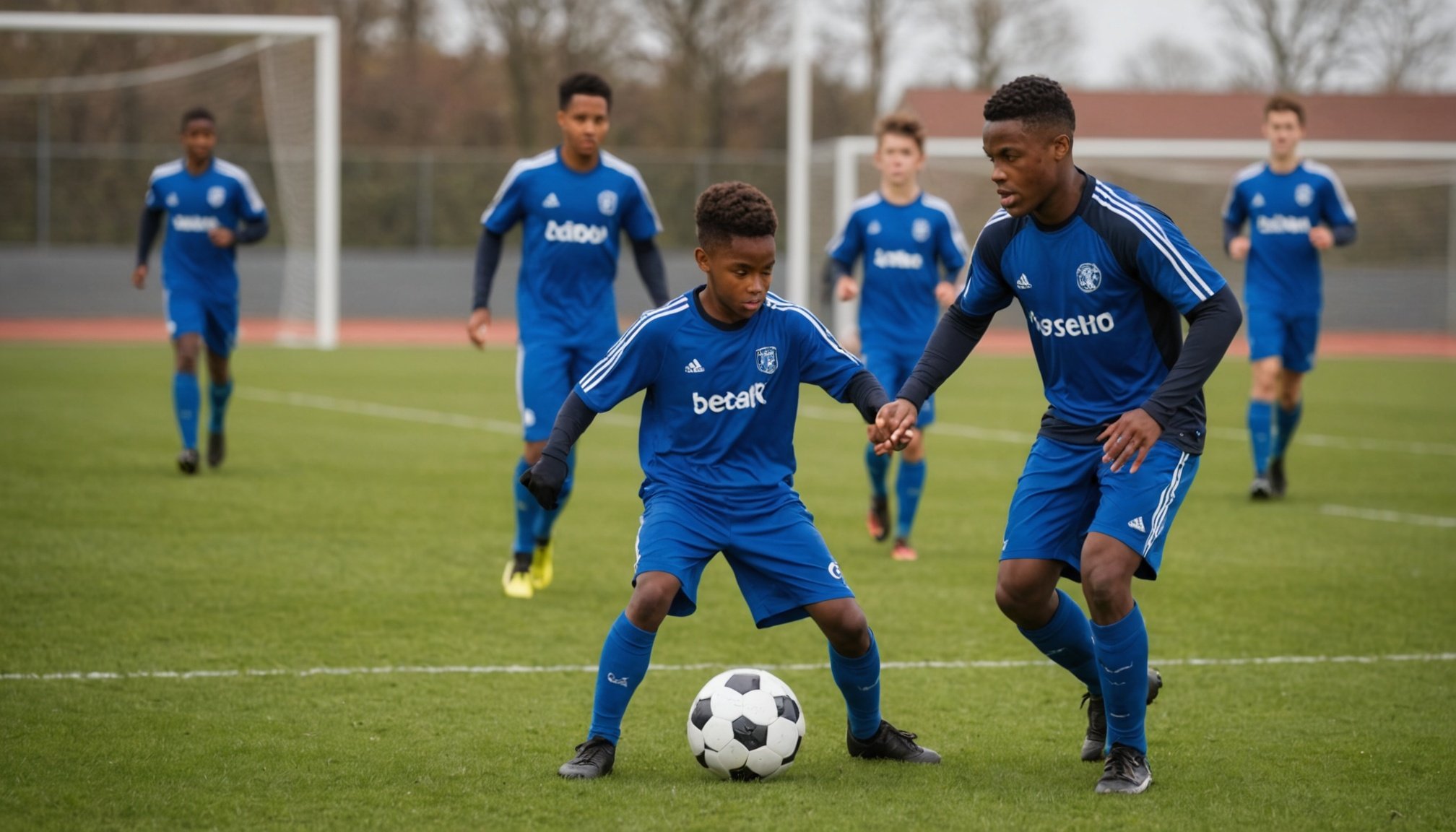Understanding Technical Skills in Youth Football
Technical skills serve as the backbone of any young footballer’s development. These abilities include a player’s talent in ball control, dribbling, passing, shooting, and defending. In youth football development, honing these skills from an early age is crucial, as they lay the groundwork for more complex tactical understanding and physical growth. It is often emphasised that players with strong technical foundations exhibit improved game intelligence, which contributes to more effective skill assessment.
Common technical skills young players should focus on include:
This might interest you : Unlocking Athletic Potential: The Surprising Advantages of Adding Yoga to a Footballer”s Training Routine
- Ball control – mastering the ball under pressure can decisively influence a game’s outcome.
- Passing accuracy – facilitates teamwork and paves the way for seamless game flow.
- Shooting technique – essential for converting opportunities into goals.
- Dribbling – enhances a player’s ability to navigate through defenders.
- Defensive skills – encompass intercepting passes and marking opponents effectively.
How well a player develops these skills significantly impacts their overall development. For instance, superior technical prowess can increase a player’s confidence, allowing them to take on more central roles within team strategies. On the flip side, a lack of technical skills might hinder a player’s ability to adjust to evolving game dynamics, potentially stalling their progression in competitive football.
Age-Appropriate Training Methods
Tailored coaching is essential in age-appropriate training for young football athletes. For children in the age groups of U6, U8, and U10, the focus should be on basic football skill development through engaging and simple activities. Adjusting these methods according to age ensures that learning remains effective and fun.
Also read : Top Strategies for Safeguarding Youth Football Players Against Common Injuries
For U6 players, playful exercises like dribbling through cones and simple passing drills aid in developing coordination and basic ball control. Introducing football through games like “tag with a ball” keeps children engaged while teaching them fundamental skills.
As children move into the U8 category, introduce slightly more structured activities. Incorporating short sprints and shooting drills helps them improve speed and accuracy. Encouraging teamwork through small-sided games fosters social and strategic skill development.
For the U10 group, training should become progressively challenging. Focus on tactical awareness by teaching positional play and introducing more complex dribbling drills. In this stage, kids can handle drills that demand critical thinking and precision.
These age-appropriate training strategies, tailored by group, not only enhance football skill development but also cultivate a lifelong love for the sport.
Practical Drills for Skill Enhancement
Developing proficiency in any sport requires dedicated practice regimens and carefully structured technical training exercises. This section delves into crucial skill enhancement drills aimed at honing your abilities.
Dribbling Drills
To improve dribbling, engage in simple isolation drills that sharpen your control and agility. Repetitive sequences, like zigzagging through cones, can significantly enhance ball-handling skills. These drills not only help in managing speed but also improve quick direction changes.
Passing and Receiving Techniques
Fun games are invaluable for refining passing and receiving skills, especially under pressure. One effective game involves players forming a circle and attempting to pass the ball rapidly and accurately, simulating in-game situations. This practice encourages quick thinking and precise coordination.
Shooting Exercises
Structured shooting practice is essential for focusing on technique and accuracy. Implement drills that isolate specific shooting scenarios, like penalty shots or corner kicks. Consistent repetition of these exercises conditions both mental focus and muscle memory, ensuring players are well-equipped for real-match conditions. Emphasize varied angles and distances to cultivate a versatile shooting ability.
Integrating Technology in Training
Incorporating technology in sports training has revolutionised how athletes enhance their skills and performance. Using various gadgets and applications, coaches and athletes can streamline training methods and improve outcomes effectively.
Devices and Apps for Skill Tracking
Numerous devices and apps are available for performance analysis and skill tracking. Wearable technology like smartwatches and fitness trackers monitor vital statistics such as heart rate, speed, and distance. By collecting this data, athletes can analyse their training regimen and make necessary adjustments to optimise performance. Mobile apps provide real-time statistics and feedback, allowing athletes to track progress over time and identify areas needing improvement.
Benefits of Video Analysis
Video analysis plays a crucial role in player development. By reviewing footage of practice sessions and actual games, athletes receive visual feedback highlighting strengths and weaknesses. This form of performance analysis enables athletes to refine their skills, enhance technique, and make strategic adjustments. With the ability to slow down and zoom in on particular movements, video analysis offers a level of insight unattainable through traditional methods.
The integration of technology in sports training is undoubtedly advancing athlete development, offering innovative ways to track, analyse, and improve skills through performance analysis and cutting-edge devices.
Successful Case Studies from Renowned Academies
Several successful academies have demonstrated remarkable outcomes through innovative training methodologies. By examining these case studies in football, we can understand effective strategies that contribute significantly to player development.
The Ajax Youth Academy, for instance, is celebrated for its emphasis on skill improvements. Their strategy focuses on developing young players with a comprehensive technical grounding, ensuring they possess the necessary skills to excel under pressure. Ajax’s training success is often attributed to a consistent emphasis on technical skills and game intelligence from a young age.
Barcelona’s La Masia is another exemplary case study in football. Their approach to training success involves nurturing players in a team-oriented environment, prioritising collective play and tactical awareness. The result is often a seamless transition of players into senior teams, fully attuned to Barcelona’s unique playing style.
These best practices can guide smaller academies. Adopting a structured training philosophy, focusing on holistic development, and maintaining a consistent coaching ethos are key takeaways. Tailoring these methods to fit individual academy resources can yield tangible outcomes, boosting player performance and development consistently.
Insights from Youth Football Experts
With youth football, the collective wisdom from seasoned coaches and trainers plays a pivotal role in shaping future stars. Coaches frequently highlight the importance of skill development. It’s not just about honing physical abilities; it involves nurturing cognitive understanding of the game.
Coaching Recommendations
Experts recommend fostering an environment where young athletes feel supported and motivated. Coach Steve Alvarez shares, “Building confidence is as crucial as technical training. An athlete’s belief in their abilities often determines their performance levels.” This suggests that creating a positive training environment can significantly impact young athletes’ growth.
Youth Football Development
Youth football development should encapsulate not just on-field skills, but life lessons as well. Mentoring strategies that involve empathy, patience, and encouragement are crucial. As Trainer Jamie Foster explains, “Mentoring goes beyond teaching; it’s about being role models and inspiring athletes to enjoy playing.”
Incorporating these expert insights into coaching practices ensures a holistic improvement trajectory for young athletes. Encouraging fun in training and learning from both successes and failures is key. As the foundation of youth sports, coaches’ roles are vital in crafting well-rounded individuals and talented players.
Recommended Resources and Equipment
Equipping young players with the right tools is critical for fostering enthusiasm and skill development in sports. Below are various training resources and equipment suggestions that can aid in enhancing players’ abilities across different sports.
Training Aids and Equipment
Investing in skill development equipment such as agility ladders, cones, or hurdle sets can be beneficial. These coaching tools help improve coordination, speed, and overall athletic performance. For personalised training, consider using resistance bands or balance boards to target specific muscle groups and refine technique.
Online Resources and Communities
Engaging with online resources can enhance learning beyond physical training. Platforms like YouTube offer free tutorials and drills for developing skills. Communities such as dedicated sports forums or social media groups provide a space to share experiences, receive coaching advice, and stay motivated.
Books and Educational Material
Books aimed at player development offer valuable insights for both coaches and parents. Titles like “The Talent Code” by Daniel Coyle explore the science of skill acquisition, while “Mindset” by Carol S. Dweck provides strategies for fostering a growth-oriented approach. Each resource caters to different aspects of development, ensuring well-rounded guidance for young athletes.











